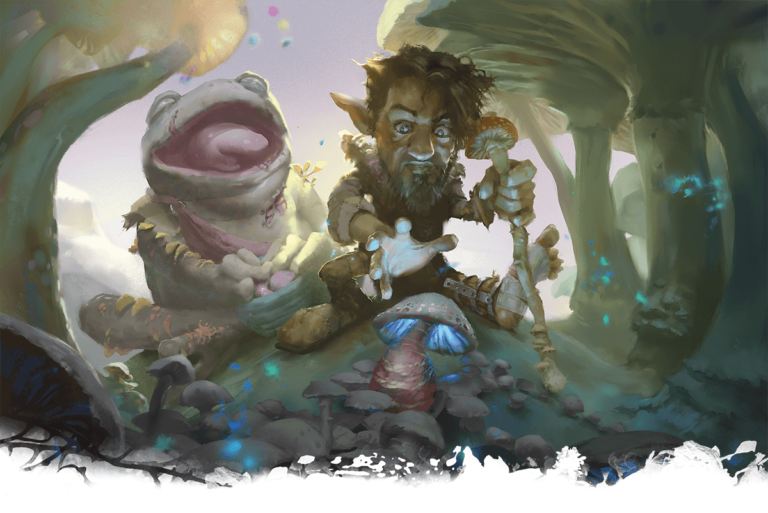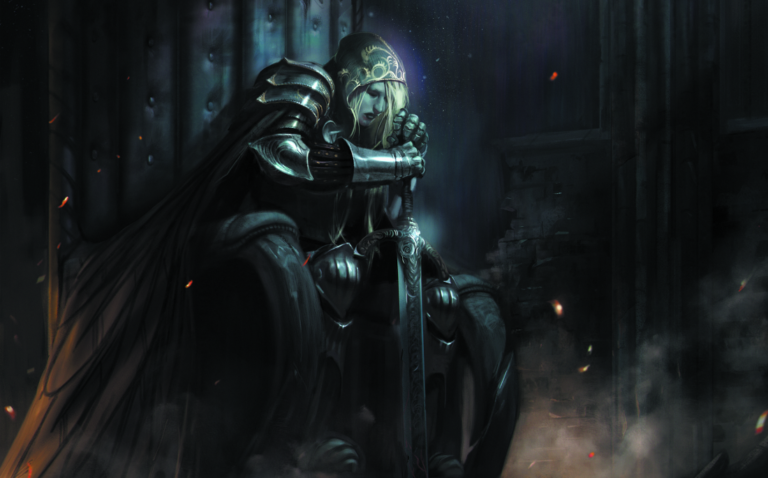Way of Mercy 5E Guide | Monk Subclass from Tasha’s Cauldron
Tasha’s Cauldron of Everything has brought some pretty dark and grim archetypes into the game. Out of them all, you can argue that the Way of Mercy is by far the grimmest. The Way of Mercy monk brings life and death into perspective. They are sworn to bring aid to those in need, and death to those beyond their help. They are realists; when magic cannot save someone, a swift end can be their only salvation. They are faceless; their identity no longer matters. But what does matter is knowing how to play them, and our Way of Mercy 5E guide will help you out.
Table of Contents
Master Life And Death: Mercy Monk 5E
The Monk of Mercy is a healing archetype. Their damage potential is fine, but nothing significantly greater than other archetypes. As a result, the Way of Mercy has no significant durability increase. They are reliant on allies (or healing themselves) to stay alive, which can get expensive.

Implements of Mercy
To begin, you get some pretty amazing proficiencies, and a cosmetic mask.
You gain proficiency in the Insight and Medicine skills, and you gain proficiency with the herbalism kit.
You also gain a special mask, which you often wear when using the features of this subclass. You determine its appearance, or generate it randomly by rolling on the Merciful Mask table.
The mask table is full of some basic designs for a pretty horrid visage to decorate your face with. You can really let your creativity come through here; the mask can realistically be anything you like. You also do not need to wear this mask if you don’t want to.
Now, the proficiencies. Monks tend to have medium to high Wisdom, so Insight and Medicine are both perfect. Insight is a weird one, but it let’s you be useful in most conversations by just listening in; Figure out what the coversants are actually saying. Medicine makes a ton of sense, and will be useful for checking injuries and patching up just a touch after a fight. It tends to be a pretty versatile skill to have, depending on how optimistic you and your DM are about skills.
Herbalism kits are actually pretty solid in general. You can use them on poisons and wounds to “augment” your ability to use Medicine. That’s… not bad! Especially early on, the Monk is going to have trouble healing diseases and poisons. So this let’s you become a very efficient natural healer.
Hand of Healing
At level 3, you also gain two abilities that essentially do the same thing. This is the first.
Your mystical touch can mend wounds. As an action, you can spend 1 ki point to touch a creature and restore a number of hit points equal to a roll of your Martial Arts die + your Wisdom modifier.
When you use your Flurry of Blows, you can replace one of the unarmed strikes with a use of this feature without spending a ki point for the healing.
One ki is a fair price for this mediocre amount of healing. It’ll scale well with time, though not necessarily overly fantastic. Magical healers will demolish what you are able to do, but you have a good source of healing, which is perfect. You can take over when a Cleric is busy.
Now, what’s actually great about this ability is the second paragraph. I’m a huge fan of Healing Word, because it only takes a Bonus Action. Well, Hand of Healing doesn’t even take a full bonus action. It’s half of a bonus action! You do need to be in melee range of both someone you want to punch and someone you want to heal, though. But, if that’s the case, you spend 1 ki point, make two Unarmed Strikes, and heal! That’s pretty awesome!
Try to only use this with the Flurry of Blows additional benefit, since that’s so action-efficient!
Hand of Harm
The other way you can spend ki on is the exact opposite.
You use your ki to inflict wounds. When you hit a creature with an unarmed strike, you can spend 1 ki point to deal extra necrotic damage equal to one roll of your Martial Arts die + your Wisdom modifier. You can use this feature only once per turn.
So, this ability does not need to spend any action, which is nice. You burst someone for another Unarmed Strike dice, and your wisdom mod. That’s great! But spending this every round will crush your ki pool. You’ll want to use this either if the target is weak to Necrotic damage, or if you really think your necrotic damage will be required to kill the target quickly.
Thankfully, with no actions required, this is a very action-efficient ability which boosts your damage, a rare quality among monks. Keep an eye on your ki and feel free to use this a lot when you either have ki to burn, or your party plans on resting afterwards.
Physician’s Touch
At level 6, you gain additional reasons to use Hand of Healing and Hand of Harm.
When you use Hand of Healing on a creature, you can also end one disease or one of the following conditions affecting the creature: blinded, deafened, paralyzed, poisoned, or stunned.
When you use Hand of Harm on a creature, you can subject that creature to the poisoned condition until the end of your next turn.
Hand of Healing is crazy strong now. This is pretty good timing for the Lesser Restoration effect, and you can cast Lesser Restoration as half of a bonus action. That’s much, much better than a Cleric needing to cast it! Hopefully your target got paralyzed next to an enemy to make this as efficient as possible. Though, it’s good to not that spending 1 Ki to heal and get the effects of Lesser Restoration is crazy worth it!
Hand of Harm got the bad end of the deal, but not by much. The creature doesn’t get a save against the poisoned effect, so the only downside is that it only lasts one turn. That’s fine, but it does mean that you only debuff an enemy for one turn with the use of your ki. At least you have another reason to use it now! It’s definitely worth the ki point; it arguably was worth the ki point before!
Flurry of Healing and Harm
At level 11, you get a ridiculous amount of versatility… for one of your Hands. And unfortunately, it’s not the one you’re looking for.
When you use Flurry of Blows, you can now replace each of the unarmed strikes with a use of your Hand of Healing, without spending ki points for the healing.
In addition, when you make an unarmed strike with Flurry of Blows, you can use Hand of Harm with that strike without spending the ki point for Hand of Harm. You can still use Hand of Harm only once per turn.
The ability to use both unarmed strikes with Flurry of Blows to heal isn’t that important. That still only heals for, at maximum, 2d12 + (about) 10. Is that bad? No. Is that good? Not really. Clerics heal for 70 guaranteed at this point. Your Healing Hand was best at picking people out of unconsciousness. Healing them twice over? That’s not going to be overly important.
However, you can now not spend a single ki point on Hand of Harm. That means you get to hit with two unarmed strikes, deal damage equal to (basically) an additional unarmed strike, and poison them. Perfect! That’s a really good use of your ki now, since you love spending ki on Flurry of Blows.
Hand of Ultimate Mercy
Your keystone, at level 17, isn’t particularly important.
As an action, you can touch the corpse of a creature that died within the past 24 hours and expend 5 ki points. The creature then returns to life, regaining a number of hit points equal to 4d10 + your Wisdom modifier. If the creature died while subject to any of the following conditions, it revives with them removed: blinded, deafened, paralyzed, poisoned, and stunned.
Once you use this feature, you can’t use it again until you finish a long rest.
Now, there are several great aspects of this.
Notably, it costs no money. You can now revive anyone you wish without spending a dime. That’s pretty great! Even Revivify normally costs 300 gold. 300 gold isn’t that much, admittedly, but you get to save it all for the low cost of 5 ki… Okay, maybe not low cost. This is a great tool to use before you go to sleep that day to bring back someone who died. The person also heals a bunch, and it’s only an action, so it’s a good emergency revive.
You’ll probably still want your Cleric or Druid to have a revive in their back pocket, since you need to spend ki a lot in combat. But at least you have a guaranteed resurrection tool.
Best Races for the Mercy Monk
The Mercy Monk is really looking for the combination of Dexterity and Wisdom that most monks want. However, they really need Wisdom. Wisdom is added to their healing and their damage now.
Pallid Elf
The Pallid Elf is an elf that’s rather good at being dark and gloomy. They have everything that makes Elf a great race – +2 Dexterity, Darkvision, free Perception, resistance to charm. However, Pallid Elves bring great Wisdom stuff to the table. Incisive Sense gives you advantage on Investigation and Insight checks… all of them! You know exactly what’s happening around a crime scene. Blessing of the Moon Weaver offers some great spells for scouting or escaping a situation. However, none of that compares to the blessing of +1 Wisdom that the Pallid Elf gets. A perfect elf to bring mercy to their foes.
Kenku
The Kenku from Volo’s Guide to Monsters are quite literally anthropomorphic ravens. Why wouldn’t they be a good choice for a plague doctor? Well, they are a great choice. They gain +2 Dexterity, +1 Wisdom. They gain two free skill proficiencies (giving the Monk a crazy 7 total proficient skills at level 3). They are great at forging, and they have the really fun Mimicry ability. You could only talk in funeral hymns, for example. This would be a legitimately fantastic character to work with!
Conclusion – Our Take on the Mercy Monk
The Mercy Monk burns through ki if you’re not very careful. But it’s also the best monk for healing, especially as an off-healer role. Try it out if you’re tired of playing Bard or Druid just for Healing Word access, and try out Tasha’s Cauldron for even more crazy builds!






